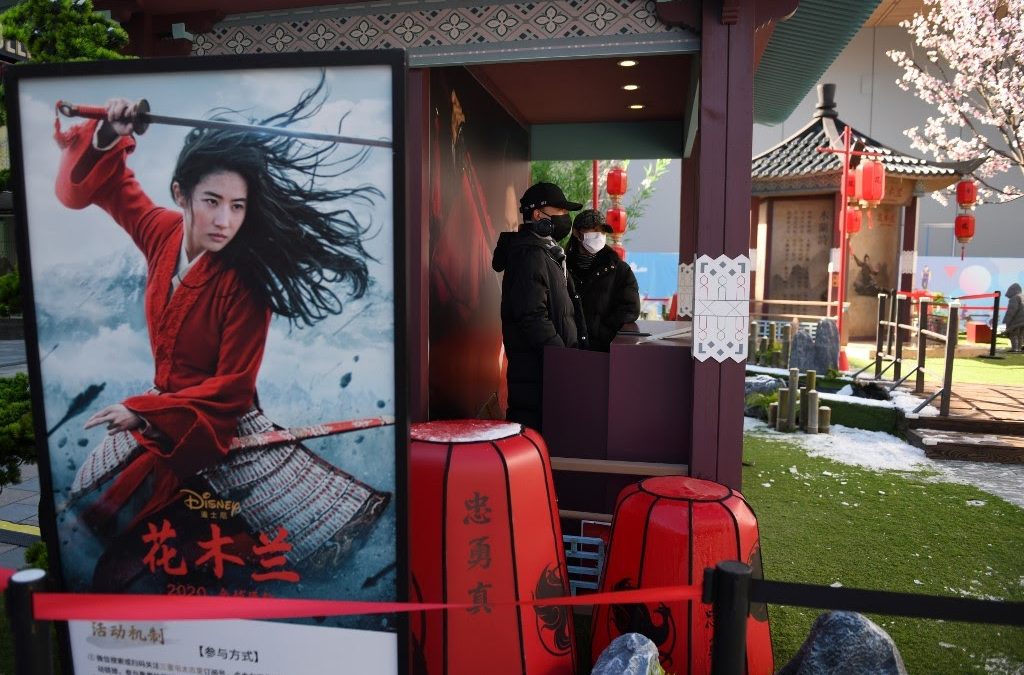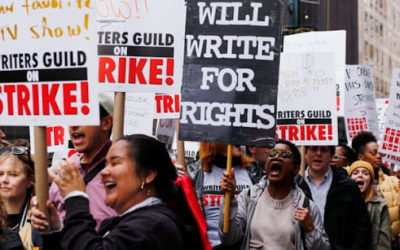This photo taken on February 16, 2020 shows two workers wearing face masks manning a promotional stand for the Disney movie ‘Mulan’ in an almost empty shopping mall in Beijing. ( AFP/GREG BAKER)
In an increasingly globalized world, several nations now more than ever find themselves collaborating with others with the intention of achieving a specific goal. No country has seen such a massive growth in international presence than China, with an economy skyrocketing over the past decade or so and capturing the attention of multiple foreign nations seeking to expand their markets in any way possible. This has led to many American companies turning to China in order to potentially collaborate with (and eventually profit off of) the growing economic giant, and no industry has its sights set on China like Hollywood.
Unlike the United States, which has seen a decreasing number of ticket sales over the past few decades, China’s box office has gone in the opposite direction, seeing rapid increases in the number of movie theaters across the nation and a boom in ticket sales as a result. Wanting to cash in on China’s increasing hunger for cinema, many of Hollywood’s largest studios have taken the Asian nation into account when crafting their various cinematic products. Perhaps the most significant American production made to appeal to the Chinese market above all else is “Mulan”, a live-action retelling of the 1998 animated Disney movie. Despite drawing heavily from this earlier work, the story has been extensively modified in order to tone down the original film’s Western-centric elements and make something more acceptable to Eastern audiences.
In theory, this sounds like a recipe for success. China and its people get to see a film intended primarily for them, and Disney gets to make a substantial profit off the tickets sold there. However, what was expected to be a production to be completed without any major problems has become anything but, and with the release of “Mulan” the previous weekend, the most recent controversy to come about from its presence can be traced to the film’s credits. While thousands of individuals and groups can be found listed, those associated with the province of Xinjiang, specifically its publicity department and the Public Safety and Tourism boards of Turpan, one of Xinjiang’s cities.
To understand the concerns surrounding the credit of these institutions, it’s important to discuss the multiple human rights violations that Xinjiang has been accused of. Since 2015, Xinjiang has been the source of imprisonment for over two million Chinese citizens, specifically those of the Islam-practicing Uyghurs ethnic group and other Turkic minorities. China has frequently denied there being any inhumanity in its decision to detain these people, claiming that such actions have been a necessary tactic to prevent terrorism and extremist activity. These locations are not concentration camps, the Chinese government claims, but rather educational facilities where people can train and establish critical vocational skills. Such claims have proven to be unconvincing for many however, and Xinjiang continues to face scrutiny for what has been repeatedly referred to as a violation of human rights.
How does “Mulan” connect to Xinjiang? No specific ties have been made public by either Disney or the Chinese government yet, although the presence of Xinjiang and its institutions proves there has been interaction to some degree. It is currently unknown how much of the film, if any of it, was filmed directly in the province, although multiple sources have alleged that they have scouted the region and even filmed some scenes there. Whatever the case may be, the reveal of these connections has led to an unprecedented amount of backlash on social media, which has called upon Disney to reveal the extent of Xinjiang’s presence in the production of “Mulan”.
Unfortunately, this is not the first time the live-action remake of “Mulan” has been dealt a setback in its path to global financial success. In August of last year, Liu Yifei, the actress playing the film’s titular protagonist, expressed support for the police in the protests that took place in the city of Hong Kong, despite the allegations that police were being excessively violent towards protestors. This led to several pro-democracy groups calling for a boycott against the film, and these calls have seen a resurgence following the film’s recent release, especially in light of the reveal that Xinjiang was involved with the film to some degree. Political controversy aside, the release of “Mulan”, originally planned to come out in March, had to be pushed back repeatedly due to the COVID-19 pandemic before Disney ultimately decided to forego a theatrical release in America and instead release the film through its streaming service Disney+ (albeit with a hefty $30 price tag).
The controversy surrounding Disney’s live-action remake of “Mulan” is a perfect example of the many issues surrounding Hollywood’s desire to claim a stake in China’s growing box office (now the second largest in the world). On the one hand, with America’s box office losing steam and studios needing to find new ways to stay in business, it’s understandable that they would want to gain the approval of China so that they can release their films in the nation (and receive a significant share of the ticket sales made there). On the other hand, the accusations of human rights violations in Xinjiang are only part of the source of criticism that the Chinese government has faced over the past few years, to a point where boycotts against China have become more and more frequent. With China so heavily involved with the production of many blockbuster hits, Hollywood doing business with the nation may not be the most ethical decision.
There may not be anything wrong with trying to appeal to as wide of an audience as possible, but when that audience includes a nation subjected to one international controversy after another, one may need to ask where to draw the line.




